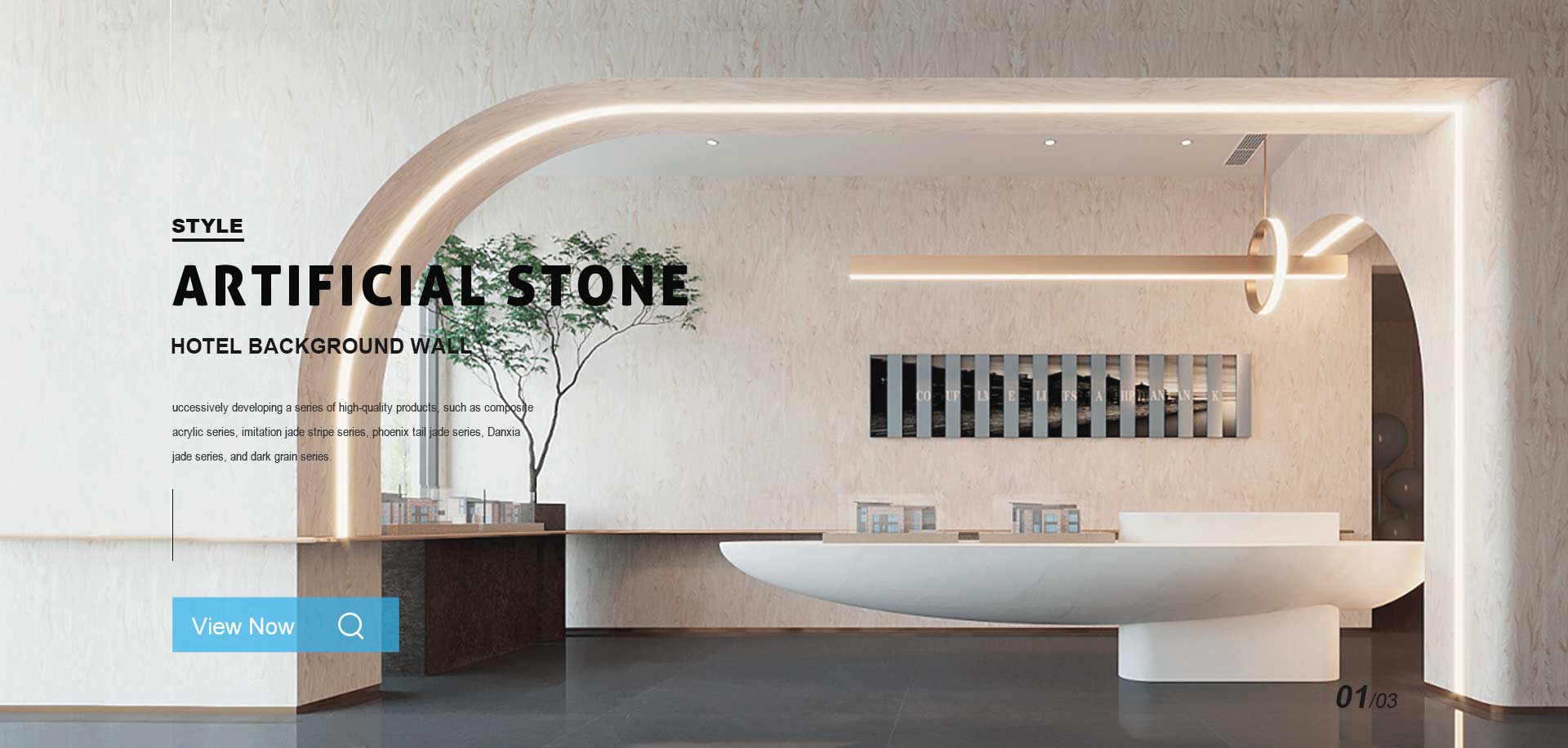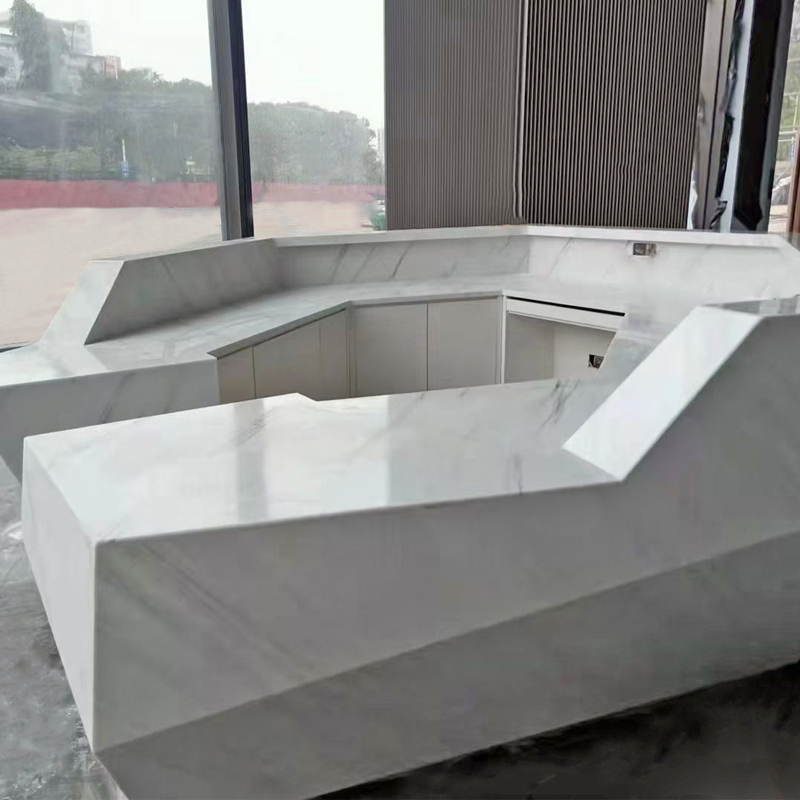
A Synthetic Stone Reception Desk is a high-end furniture piece crafted from engineered stone materials, designed specifically for reception areas in commercial and institutional settings. These desks combine 93-95% natural quartz or other mineral aggregates with 7-5% polymer resins and pigments, creating a durable and aesthetically pleasing surface. Unlike natural stone, synthetic stone offers greater consistency in color and pattern, with a flexural strength of 40-50 MPa and compressive strength exceeding 150 MPa, making it exceptionally resistant to impact and heavy use.
The manufacturing process involves vacuum vibration compaction at 100-120°C, resulting in a Non-Porous Surface with water absorption rates below 0.02%. This gives Synthetic Stone Desks superior stain resistance compared to natural materials like marble or granite.

Synthetic stone reception desks exhibit remarkable durability, with a Mohs hardness rating of 7-8, comparable to natural quartz. They demonstrate impact resistance of 10-12 kJ/m² (measured by Charpy impact test) and can withstand point loads up to 500 kg without deformation. The material's flexural modulus ranges from 30-40 GPa, ensuring minimal deflection under normal use conditions.
The engineered surface achieves a gloss level of 85-95 GU (measured at 60° angle) when polished, with surface roughness (Ra) values below 0.5 μm. This creates an exceptionally smooth finish that resists bacterial growth, achieving 99.9% bacterial reduction in standard antimicrobial tests. The material maintains color stability with ΔE < 2.0 after 1,000 hours of accelerated UV exposure testing.
Synthetic stone demonstrates excellent thermal stability, with a coefficient of thermal expansion of 7-9 × 10⁻⁶/°C and can withstand temperatures up to 150°C without damage. It shows exceptional resistance to common chemicals, including:
Acid resistance: No visible effect after 24-hour exposure to 3% acetic acid or 10% citric acid
Alkali resistance: Withstands 5% sodium hydroxide solution with no surface degradation
Stain resistance: Scores 5/5 on ISO 10545-14 for common staining agents (coffee, red wine, iodine)
The non-porous surface (porosity < 0.1%) prevents liquid absorption, making it highly hygienic with a microbial reduction rate of 99.6% after standard cleaning. Surface hardness maintains at ≥6.5 Mohs even after 50,000 abrasion cycles (EN 13310 test method).
In corporate environments, synthetic stone desks project professionalism with their sleek appearance while withstanding daily use from 150-300 visitor interactions per day. The material's sound absorption coefficient of 0.05-0.10 at 500Hz helps maintain acoustic comfort in busy lobbies.
Hospitals and clinics benefit from the material's antibacterial properties (tested to ISO 22196) and compatibility with hospital-grade disinfectants. The seamless construction eliminates joints where pathogens could accumulate, achieving <1 CFU/cm² in microbial swab tests.
Hotels and resorts utilize these desks for their 24/7 operational durability and luxury appeal. The surface maintains its appearance after 10,000+ cleaning cycles with common hotel cleaning agents, with gloss retention exceeding 90% after five years of use.
Universities and schools benefit from the material's vandal resistance, withstanding intentional impacts up to 50 Joules without cracking. The scratch resistance (4H pencil hardness) prevents damage from everyday items like keys or pens.
High-end retail stores leverage the material's color consistency (ΔE < 1.0 across batches) for brand-aligned reception areas. The surface shows no visible wear after 1 million rubs in ASTM D6279 abrasion testing.
Use a pH-neutral cleaner (pH 7-8) diluted to 2-5% concentration with warm water (<40°C). Microfiber cloths with a 180-220 gsm weight provide optimal cleaning without scratching. Avoid abrasive pads with Mohs hardness >5 to prevent surface dulling.
For stubborn stains, prepare a poultice using 30% hydrogen peroxide and powdered chalk (1:3 ratio). Apply with a 0.5mm thickness, cover with plastic for 12-24 hours, then rinse. This method removes 98% of organic stains without surface damage.
Every 6-12 months, apply a nanotechnology-based sealer (containing SiO₂ particles <50nm) to maintain hydrophobicity. This creates a contact angle of >110°, causing liquids to bead up. Avoid wax-based products that can create haze buildup (>3 GU loss) over time.
For minor chips (<2mm depth), use a UV-curing epoxy with 380-420nm wavelength curing light. Match the repair compound's viscosity (800-1,200 cP) to ensure proper filling. After curing, polish with 3,000-5,000 grit diamond pads to restore surface continuity.
Important: Never use cleaners containing hydrofluoric acid (HF) or muriatic acid, as these can etch the surface at concentrations as low as 0.5%. Avoid prolonged exposure to pH <2 or >12 solutions, which can cause polymer matrix degradation over time.
Previous: Synthetic Stone Reception Desks
Next: Synthetic Marble Sink